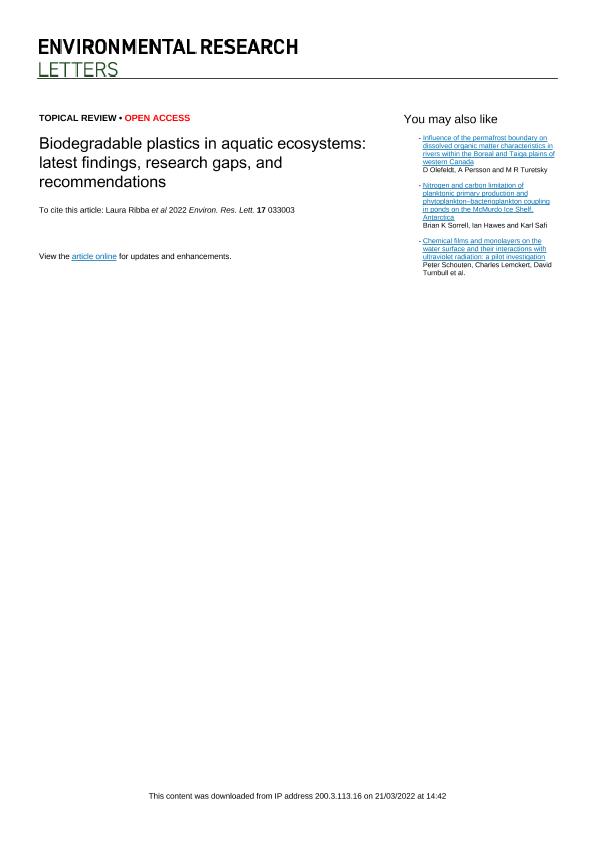Mostrar el registro sencillo del ítem
dc.contributor.author
Ribba, Laura Gabriela

dc.contributor.author
Lopretti, Mary
dc.contributor.author
Montes de Oca Vásquez, Gabriela
dc.contributor.author
Batista, Diego
dc.contributor.author
Goyanes, Silvia Nair

dc.contributor.author
Vega Baudrit, José Roberto
dc.date.available
2022-07-01T11:10:00Z
dc.date.issued
2022-03
dc.identifier.citation
Ribba, Laura Gabriela; Lopretti, Mary; Montes de Oca Vásquez, Gabriela; Batista, Diego; Goyanes, Silvia Nair; et al.; Biodegradable plastics in aquatic ecosystems: Latest findings, research gaps, and recommendations; IOP Publishing; Environmental Research Letters; 17; 3; 3-2022; 1-24
dc.identifier.issn
1748-9326
dc.identifier.uri
http://hdl.handle.net/11336/161031
dc.description.abstract
The negative impact of plastic accumulation in aquatic ecosystems is a known and undeniable problem. However, while many of the scientific community's countermeasures against such accumulation target the effects of the most common commodity plastics, the consequences of so-called 'biodegradable' plastics in those ecosystems are seldom discussed. After all, though their alleged biodegradability sustains the widespread belief that they are harmless to the environment, because a material's fate determines its classification as biodegradable or not, many plastics classified as biodegradable do not in fact meet the required norms and standards of biodegradability in aquatic ecosystems. Furthermore, during the past five years, the scientific community has shown that the degradation of such plastics can generate bio-microplastics that have effects similar to or worse than those of conventional microplastics (MPs). Against that background, this review details the latest findings regarding how biodegradable plastics can influence aquatic ecosystems and thus cause adverse health effects in living organisms and/or act as vectors of chemical pollutants. Beyond that, it identifies the key aspects of such trends to be investigated in greater depth, including the need to consider a wider variety of biodegradable plastics and to develop systematic methods that allow quantifying and identifying the remains of those pollutants in living species. Other aspects worth considering include the arrival and mobilisation dynamics of MPs in oceans. The ways in which small animals fed by filtering (e.g. red crabs and other zooplankton organisms) move MPs through the water column and into food webs also merit attention, for those MPs are ingested by numerous species at different trophic levels, at which point bioaccumulation in tissues has to be considered as a factor of toxicity. This review closes with a series of recommendations and perspectives for future studies on 'biodegradable plastics' in aquatic ecosystems.
dc.format
application/pdf
dc.language.iso
eng
dc.publisher
IOP Publishing

dc.rights
info:eu-repo/semantics/openAccess
dc.rights.uri
https://creativecommons.org/licenses/by-nc-sa/2.5/ar/
dc.subject
BIODEGRADABLE
dc.subject
MICROPLASTICS
dc.subject
TERM
dc.subject.classification
Ciencias Medioambientales

dc.subject.classification
Ciencias de la Tierra y relacionadas con el Medio Ambiente

dc.subject.classification
CIENCIAS NATURALES Y EXACTAS

dc.subject.classification
Otras Ingeniería de los Materiales

dc.subject.classification
Ingeniería de los Materiales

dc.subject.classification
INGENIERÍAS Y TECNOLOGÍAS

dc.title
Biodegradable plastics in aquatic ecosystems: Latest findings, research gaps, and recommendations
dc.type
info:eu-repo/semantics/article
dc.type
info:ar-repo/semantics/artículo
dc.type
info:eu-repo/semantics/publishedVersion
dc.date.updated
2022-06-30T19:03:43Z
dc.journal.volume
17
dc.journal.number
3
dc.journal.pagination
1-24
dc.journal.pais
Reino Unido

dc.description.fil
Fil: Ribba, Laura Gabriela. Instituto Nacional de Tecnología Industrial; Argentina. Universidad de Buenos Aires. Facultad de Ciencias Exactas y Naturales. Departamento de Física; Argentina. Consejo Nacional de Investigaciones Científicas y Técnicas; Argentina
dc.description.fil
Fil: Lopretti, Mary. Universidad de la República; Uruguay
dc.description.fil
Fil: Montes de Oca Vásquez, Gabriela. Laboratorio Nacional de Nanotecnologia (lanotec) ; Centro Nacional de Alta Tecnologia;
dc.description.fil
Fil: Batista, Diego. Laboratorio Nacional de Nanotecnologia (lanotec) ; Centro Nacional de Alta Tecnologia;
dc.description.fil
Fil: Goyanes, Silvia Nair. Consejo Nacional de Investigaciones Científicas y Técnicas. Oficina de Coordinación Administrativa Ciudad Universitaria. Instituto de Física de Buenos Aires. Universidad de Buenos Aires. Facultad de Ciencias Exactas y Naturales. Instituto de Física de Buenos Aires; Argentina
dc.description.fil
Fil: Vega Baudrit, José Roberto. Laboratorio Nacional de Nanotecnologia (lanotec) ; Centro Nacional de Alta Tecnologia;
dc.journal.title
Environmental Research Letters

dc.relation.alternativeid
info:eu-repo/semantics/altIdentifier/url/https://iopscience.iop.org/article/10.1088/1748-9326/ac548d
dc.relation.alternativeid
info:eu-repo/semantics/altIdentifier/doi/http://dx.doi.org/10.1088/1748-9326/ac548d
Archivos asociados
